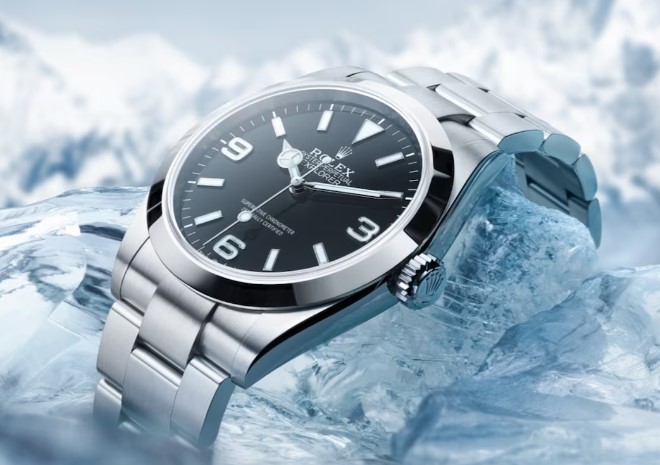
The Rolex Explorer is one of the most iconic watches that the Swiss company has ever produced. It’s so successful that numerous imitators have surfaced over the years. In addition to the out-and-out fakes, you’ll spot elements snatched straight from the Explorer in numerous timepieces produced by Rolex’s high, and lower-end, competitors. Fittingly, the iconic wristwatch has an equally ironic, exploration-related, origin story.
A Rolex Explorer prototype was strapped to the wrist of Sir Edmund Hillary, who was the first man to summit Mount Everest in 1953. The prototype survived the journey, and went into production shortly afterwards.
Since then, the watch (or at least one edition of it) has been on every serious Rolex collectors wishlist, and on the wrists of several other notable people including James Bond author Ian Fleming. Aside from one edition which stretched out to 39mm, the Explorer is also one of Rolex’s most consistent watches. If you buy one you’ll be getting something rugged, compact, and with large, easy-to-read numerals at the 3, 6, and 9 positions.
Again, with few exceptions, the Explorer’s look is pretty uniform. No fancy dials, no unnecessary bling. Just a stainless steel case, a steel strap, and a black watch face. For the most part anyway, as with everything — early models were a little different. The closest thing you can likely find to the prototype Hilary wore is a reference 6150. This dagger-handed beauty looks like a fairly plain Oyster Perpetual, once you overlook the period features and the black “Explorer” dial. If you’re looking for the first watch to have the word “Explorer” printed on it, you’ll want the slightly later 6350. Both of these pieces are rare, highly sought after, and will cost you a pretty penny.
Even slightly later Explorers are very expensive. Models from the 1960s can cost well into six figures. If you just want an Explorer, and aren’t too bothered about the model, year, or exact history, something made between the 1990s and now is probably your cheapest good option. You can find more affordable pieces, but that ups your odds of getting burned.
If you are looking for a “cheap” vintage Explorer, you should probably avoid models with the reference 5500. Although 5500s are some of the most affordable Explorers on the market, they shared a case and movement with the much cheaper Rolex watch — the Air King. As a result, plenty of people buy a vintage Air King and a matching Explorer dial before selling it on for a good profit. Without the original paperwork, even experts will struggle to spot the difference between the two Rolex watches.
You can also celebrate watches making it to the top of the world’s highest peak while avoiding Rolex altogether. It turns out an early version of the Explorer wasn’t the only thing that made it to the top of Everest in the early 1950s.

Hillary took another watch with him
While the Rolex was the most famous thing on Sir Edmund Hillary’s wrist during his ascent of Everest, it wasn’t the only watch he had with him. The legendary Kiwi climber had another timepiece made by Smiths — a smaller manufacturer based in England.
Following Hillary’s return, he reported that the Smiths DeLuxe he was wearing “performed very well.” Though he didn’t receive a factory-spec watch. The manufacturer did switch out the standard lubricants for oils that could better cope with the extreme conditions found at the top of the world.
The Smiths name is still around in the watchmaking world, but the original company it was part of now focuses on engineering. Its watchmaking division outlasted every other English wristwatch manufacturer, but still ended up closing its doors in the 1970s. The brand itself currently seems to be mired in copyright purgatory.
Platts, which owns timefactors.com produces a “tribute” watch that carries the Smiths Everest name, and has the appearance of a vintage Rolex Explorer. The tributes are available for under $500, which is a minute fraction of the price you would pay for a vintage Rolex Explorer 1016 — the men’s watch it appears to be cloned from.
But while $500 isn’t much for a watch with a story behind it, you do have to question its actual value. Beyond its name, it’s just another moderately decent Japanese movement clad in a copy of a vintage Explorer’s case. There isn’t any pedigree or legacy there.
You can buy a vintage Smiths Everest, which most certainly wasn’t a knock-off Rolex, for a few thousand dollars. There are many other vintage Smiths pieces worth collecting too, including a number of models produced for the British Army, and an early 1950’s DeLuxe — just like the one Hillary wore. Just look for the models with “Made in England” on the dial if you want to collect something from the watchmaker’s peak. The “Made in Britain” examples were mass-produced in a Welsh factory and are generally seen as less desirable.



